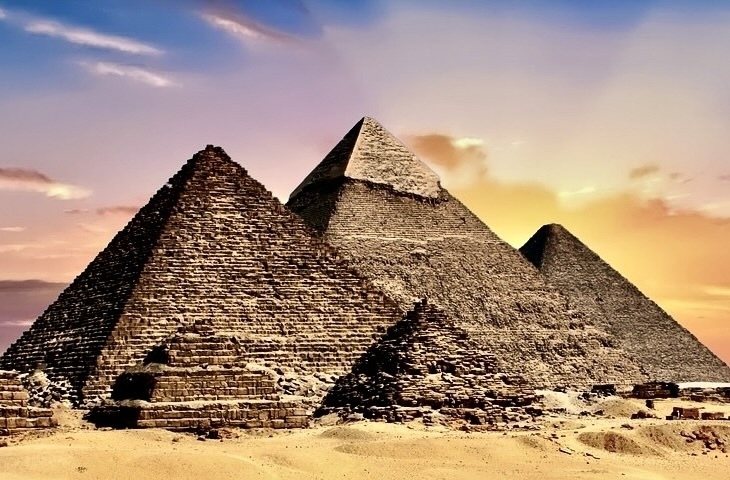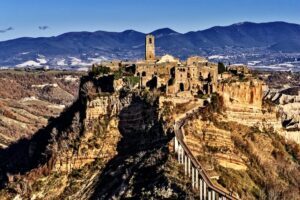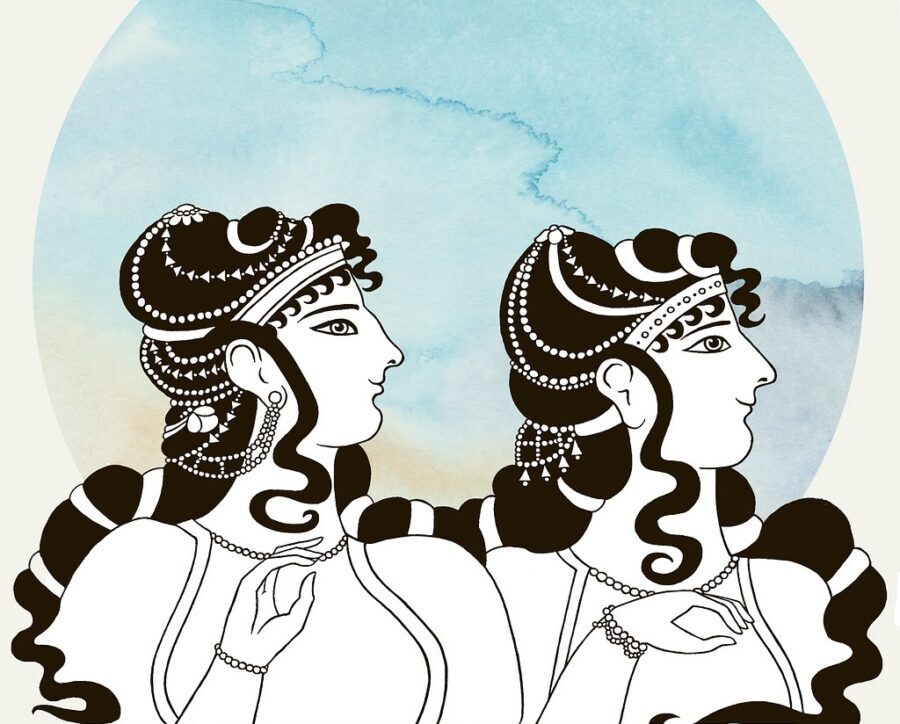
Set artfully within the classic spaces of the famous Getty Villa Museum along California’s Los Angeles coastline rests, for a time, a remarkable treasure that affords a rare view of a time and place over 3,000 years ago in ancient Greece. At once, it tells a story that bridges the legendary myth of the Trojan War, a storied Aegean kingdom, and a mysterious elite warrior buried in a lone shaft tomb in southwestern Greece….
Troy
It was a perfectly strategic location for the ancients to build a city.
Commanding a point at the south entrance of the Dardanelles (Hellespont), it controlled the land route that extended northward along the western Anatolian coast and over a narrow point of the Dardanelles to the present-day European coast. From an elevated eyeshot looking west from the site across 4 miles of the plain of the Scamander River (Küçükmenderes Çayı), is the Aegean Sea. Today, this place is characterized by a mound, or tell, known as Hisarlik, meaning ‘place of fortresses’ in Turkish. Most archaeologists know it as the site of legendary ancient Troy, made famous in classical and popular literature with Homer’s Iliad as the besieged city of the Trojan War.
___________________________
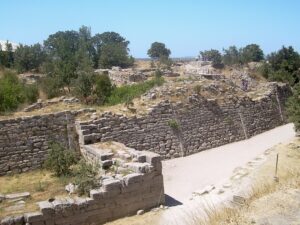
These walls of the acropolis belong to Troy VII, which is identified as the site of the Trojan War (c. 1200 BC). CherryX, CC BY-SA 3.0, Wikimedia Commons
___________________________
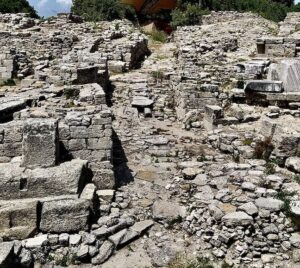
More remains of Troy. Kizildeniz, CC BY-SA 4.0, Wikimedia Commons
___________________________
There was at this place, however, more than one ‘Troy’. Succeeding archaeological excavations have revealed evidence of multiple settlements of varying size and complexity, each built on top of the remains of the preceding habitation and forming a layer-cake physical account of cities here beginning just before the Early Bronze Age (c. 3300–2100 BCE) and extending to the 3rd century AD — a remarkably long human occupation of about 3500 years. But Homer’s Troy, according to archaeologists, may arguably be identified with the Late Bronze Age occupation level designated in archaeology-speak as Troy VIIa. In this level, excavations evidenced structures that were set close together within a fortress, with almost every structure featuring one or more massive storage jars sunk into the ground, mouths exposed at the surface. It was a short-lived occupation level, showing measures that suggested preparations for a significant military siege. Analysis of human remains indicated by interpretation that this city was captured, looted, and burned. Imported Mycenaean pottery found in this level helped to date the level to between 1260 and 1240 BCE. In storytelling, this was the time of Homer’s Troy-sieging Achaeans — Agamemnon, Achilles, Odysseus — historically, the Mycenaeans. Among them also was Nestor, king of Pylos….
King Nestor and Pylos
…….we went to Pylos and to Nestor, the shepherd of the people, and he received me in his lofty house and gave me kindly welcome, as a father might his own son who after a long time had newly come from afar: even so kindly he tended me with his glorious sons…….
These words of Telemachus, the son of Odysseus and Penelope as penned by Homer in Book 17 of the Odyssey give us this ancient literary glimpse of Pylos, where the legendary King Nestor made his domicile. But beyond Homer the excavations over the last century have revealed a tangible place — a Pylos that can actually be seen and touched, verifying the historicity of the legendary place.
Evidence for human settlement at Pylos extends as far back as the Neolithic, though it is best known as an important center during Mycenaean times (1600 -1100 BC). Pylos as a state extended over 2,000 square kilometers (770 sq mi) with a population that may have ranged from 50,000 to as many as120,000 people. In 1939, a joint Hellenic-American expedition was formed with the Greek Archaeological Service under Epano Englianos and Carl Blegen with the University of Cincinnati. Excavations began on 4 April 1939, with dramatic results. Almost immediately, stone walls, fresco fragments, Mycenaean pottery and inscribed tablets were unearthed. Blegen identified monumental structural remains as the great “Palace of Nestor”, and although it is not certain that this was indeed such, Linear B tablets found during the excavations indicated that the site in which the structure is located was anciently called Pylos. In fact, about 1,000 Linear B tablets were unearthed. Translation of the tablets confirmed that they were part of a royal archive, and that the palace functioned as the administrative, political and financial center of the Mycenaean region of Messenia.
______________________
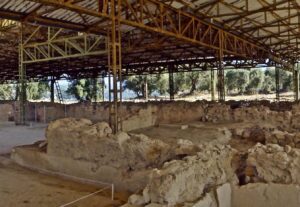
Above and below: the covered area of the excavated remains of Nestor’s Palace. Fæ, Creative Commons Attribution-Share Alike 3.0 Unported license, Wikimedia Commons
______________________
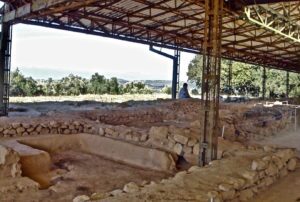
____________________
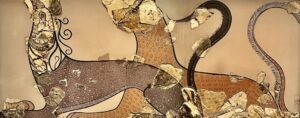
Wall fresco of lions and griffins that decorated the walls of the “Queen’s Hall” at the Palace of Nestor. As exhibited at the special exhibit, The Kingdom of Pylos: Warrior-Princes of Ancient Greece, at the Getty Villa in Los Angeles.
____________________
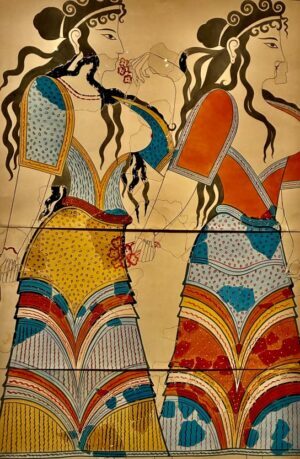
Two women walking in procession wearing Minoan-style flounced skirts. Found in a plaster dump northwest of the palace. As exhibited at the special exhibit, The Kingdom of Pylos: Warrior-Princes of Ancient Greece, at the Getty Villa in Los Angeles.
____________________
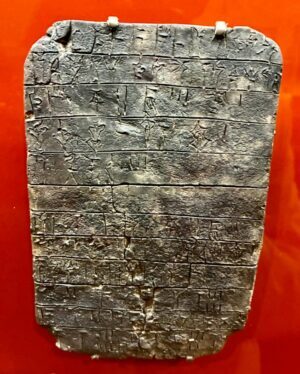
Tablets inscribed in Linear B, like this one, were found among the excavated material from the remains of the Palace of Nestor. As exhibited at the special exhibit, The Kingdom of Pylos: Warrior-Princes of Ancient Greece, at the Getty Villa in Los Angeles.
____________________

Plan of the excavated remains of the Palace of Nestor. 1-Entrance. 2-Court. 3-Anchamber. 4-Megaron(main hall). 5-Storerooms with olive oil. 6-Storerooms with wine. 7-Archives. 8-Propylon. 9-Bath.
10-Small megaron.
____________________
More recently, a team of archaeologists, consisting of director archaeologists Jack Davis and Sharon Stocker, along with a group of student volunteers, from the University of Cincinnati, conducted excavations not far from the site of the palace. In preliminary survey work, Stocker noted that “there were noticeable concentrations of rocks on the surface….”* These were watermelon-sized stones. And there were thousands. They were the remains of collapsed beehive-shaped (tholos) tombs the ancients constructed at this location millennia ago, during the Late Bronze Age. In the spirit and style of archaeology, the team removed them carefully one at a time. The painstaking work eventually revealed two tombs, one of them as deep as nearly 15 feet below the surface. “It was like going back to the Mycenaean Period. They had placed them by hand in the walls of the tombs and we were taking them out by hand,” Stocker said.*
Their work soon began to pay off. “By the end of the first week we knew we had something that was really important,” said Stocker.* And the finds were remarkable. These were clearly princely tombs. Excavations yielded “thousands of small pieces of gold foil, beads, pieces of faience, small bits of bronze and the occasional piece of silver”, according to Stocker, including an agate sealstone emblazoned with two genii (mythological lion-like creatures), a gold ring featuring two bulls flanked by sheaves of barely grain, and a gold pendant showing what could be the Egyptian goddess Hathor. These finds, along with the small fragments of gold foil and other small artifact fragments, clearly suggested wealth and status. Some news releases reported that the gold foil indicated the walls had once been covered in gold leaf. But “there is no evidence that the tomb walls were actually covered with gold leaf,” says Stocker. “[Carl] Blegen [excavator of the Palace of Nestor] speculated as much, based on the quantity of gold leaf that was found in Tholos IV, which was excavated by his team member, Lord William Taylour, in 1953”. In any case, the finds and materials clearly point to tombs that once interred individuals or families of singular wealth and/or status, as well as a capacity to carry out a broad network of trade relationships in the Eastern Mediterranean — evidenced by materials such as amber from the Baltic, amethyst from Egypt, and imported carnelian. The researchers employed extensive use of photogrammetry and digital mapping to record and document in detail the location and orientation of all objects within the tombs. This was important, according to director Davis, as it afforded the ability to “see all levels as we excavated them and relate them one to the other in three dimensions,” essential for analyzing, understanding and interpreting the tombs and the significance and meaning of their contents.*
_________________________
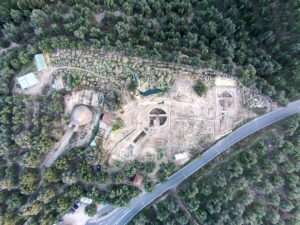
An aerial view of the site shows the Tholos IV tomb, far left, found by UC archaeologist Carl Blegen in 1939 in relation to the two family tombs called Tholos VI and Tholos VII, uncovered by the team of UC archaeologists Jack Davis and Sharon Stocker. Aerial photo/Denitsa Nenova/UC Classics, as published in the article, Uncovering the Early Mycenaeans in Popular Archeology Magazine, January 7, 2020.
_________________________
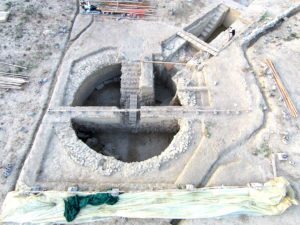
UC archaeologists discovered two Bronze Age family tombs. The round tombs, called Tholos VI and VII, contained artifacts that could shed new light on life in ancient Greece. Aerial photo/Denitsa Nenova/UC Classics, as published in the article, Uncovering the Early Mycenaeans in Popular Archeology Magazine, January 7, 2020.
_________________________

The floor of Tholos VI, one of two family tombs UC archaeologists discovered, is composed of giant stone slabs likely taken from the ruins of the Palace of Nestor during the Late Bronze Age. Photo/UC Classics, as published in the article, Uncovering the Early Mycenaeans in Popular Archeology Magazine, January 7, 2020.
_________________________
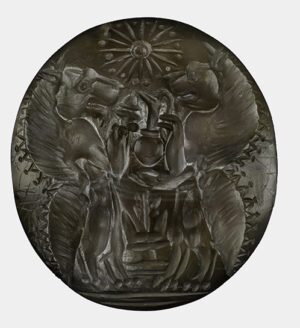
Carnelian sealstone featuring two mythological creatures called genii with serving vessels and incense over an altar. Photo/Jeff Vanderpool/UC Classics, as published in the article, Uncovering the Early Mycenaeans in Popular Archeology Magazine, January 7, 2020.
_________________________
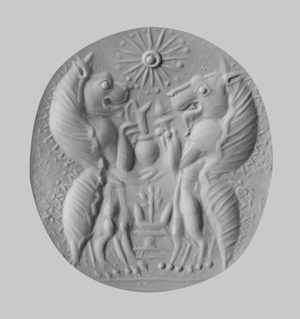
A modern putty impression of the carnelian seal stone. Photo/Jeff Vanderpool/UC Classics, as published in the article, Uncovering the Early Mycenaeans in Popular Archeology Magazine, January 7, 2020.
_________________________
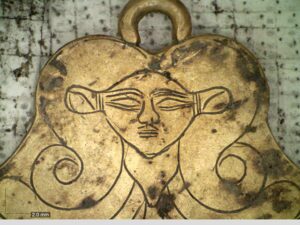
Gold pendant found in the family tombs, featuring the likeness of Hathor, an Egyptian goddess who protected of the dead. Photo/Vanessa Muro/UC Classics, as published in the article, Uncovering the Early Mycenaeans in Popular Archeology Magazine, January 7, 2020.
_________________________
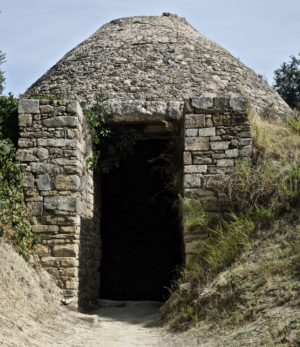
Tholos tomb IV at the Palace of Nestor site, built ca. 1550-1500 BC. Excavated by Blegen. Peulle, Wikimedia Commons, Creative Commons Attribution-Share Alike 4.0 International
_________________________
The Tomb of the Griffin Warrior
Arguably one of the most remarkable discoveries at Pylos emerged in 2015, as an archaeological team headed by Davis and Stocker (University of Cincinnati) were excavating what appeared at first to be an otherwise unremarkable stone-lined shaft tomb. This description changed very quickly, however, as they began to encounter relatively intact objects made of bronze. Their efforts eventually led to the skeletal remains of an adult male and nearly 1500 artifacts, some of the artifacts featuring rich iconography, and all associated with a single burial. Dated to about 1500 B.C. based on pottery shards found at the location, the shaft tomb and its contents have turned out to be, according to Stocker, “one of the most magnificent displays of prehistoric wealth discovered in mainland Greece in the past 65 years.”** Stocker would know—after years of experience investigating an area rich with evidence of an ancient presence long before the classical Greeks, she had never personally encountered a single burial quite like this one.
_____________________________
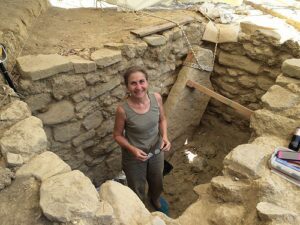
Sharon Stocker stands within the excavated shaft tomb. Courtesy Department of Classics, University of Cincinnati, as published in the article, Uncovering the Early Mycenaeans in Popular Archeology Magazine, January 7, 2020.
_____________________________
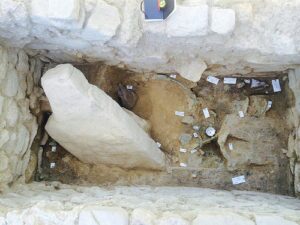
Viewed from above, the excavated Griffin Warrior Tomb, with the one-ton capstone which dominated the scene of the tomb details during the excavation. Courtesy Department of Classics, University of Cincinnati, as published in the article, Uncovering the Early Mycenaeans in Popular Archeology Magazine, January 7, 2020.
_____________________________
The inventory of finds was astounding. As reported by M.B. Reilly of the University of Cincinnati in the related UC Magazine article, the object tally included the following:
The skeleton of an adult male, age approximately 30 – 35 years who would have stood about five-and-a-half feet tall, placed upon his back when buried;
At his left chest, a sword, three feet in length, featuring an ivory hilt decorated with gold in an embroidery design;
Beneath the sword, a small dagger featuring a similarly designed gold hilt;
More bronze weapons laying at his legs and feet;
Four solid gold seal finger rings;
A 30-inch long necklace of box-shaped gold wires with two gold pendants decorated with ivy leaves;
Numerous well-preserved gold beads;
Two gold cups and six silver cups, one with a gold rim;
Bronze cups, bowls, amphora, jugs, and a basin;
More than 50 seal stones featuring intricate carvings of goddesses, altars, reeds, lions, bulls – some with human bull jumpers flying over their horns. All seal stones were in Minoan style and likely originated in Crete;
Pieces of carved ivory, one featuring a griffin with large wings and another showing a lion attacking a griffin;
Six ornate ivory combs, implying that he may have had long hair;
Over 1,000 beads of carnelian, amethyst, jasper and agate. Archaeologists suggest that some of the beads may have decorated a fabric burial shroud – as suggested by several square inches of associated woven threads;
Thin bands of bronze, likely from long decayed body armor; and
Wild boar’s teeth, likely from a warrior’s helmet.**
____________________________
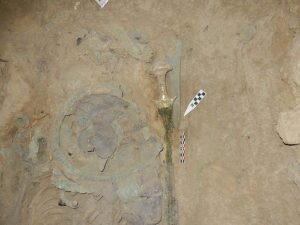
Above and below: The three-foot sword found next to the skeletal remains. Courtesy Department of Classics, University of Cincinnati, as published in the article, Uncovering the Early Mycenaeans in Popular Archeology Magazine, January 7, 2020.
____________________________
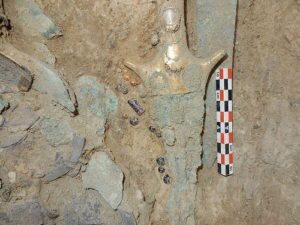
____________________________
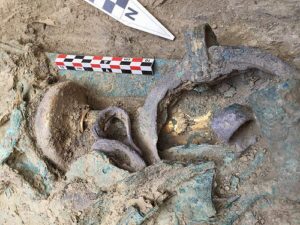
Found within the tomb: A meter-long slashing sword with an ivory handle covered in gold. Courtesy Department of Classics, University of Cincinnati, as published in the article, Uncovering the Early Mycenaeans in Popular Archeology Magazine, January 7, 2020.
____________________________
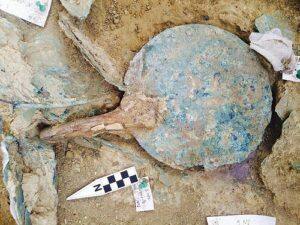
A bronze mirror with an ivory handle, found within the tomb. Courtesy Department of Classics, University of Cincinnati, as published in the article, Uncovering the Early Mycenaeans in Popular Archeology Magazine, January 7, 2020.
____________________________
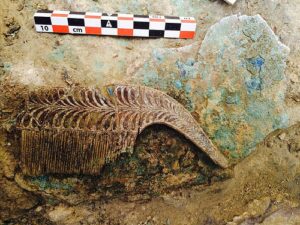
Ivory comb, one of six, found within the tomb. Courtesy Department of Classics, University of Cincinnati, as published in the article, Uncovering the Early Mycenaeans in Popular Archeology Magazine, January 7, 2020.
____________________________
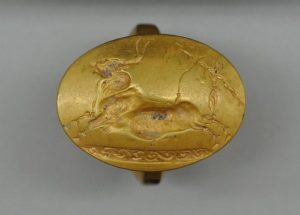
One of four solid gold rings found within the tomb. This one features a Cretan bull-jumping scene. Courtesy Department of Classics, University of Cincinnati, as published in the article, Uncovering the Early Mycenaeans in Popular Archeology Magazine, January 7, 2020.
____________________________
From analysis of the burial, archaeologists could see that many of the burial objects were originally placed above the interred on top of his wooden coffin, which had been initially crushed by a fallen one-ton stone (likely the cap stone of the burial), the wooden coffin having long since decayed and collapsed and leaving the objects resting upon the skeleton. Further analysis of the skull indicated that he had a broad face with close-set eyes and a strong jaw.
__________________________
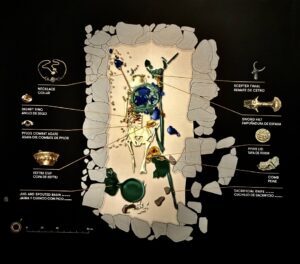
Graphic representation of the tomb and tomb remains and objects as displayed at the special exhibit, The Kingdom of Pylos: Warrior-Princes of Ancient Greece, the Getty Villa Museum.
__________________________
The skeletal remains within the context of these finds clearly suggested the burial of a high status individual, perhaps even a king, or wanax, as Mycenaean kings or lords were called anciently. The man represented by the remains has been dubbed the “griffin warrior” by Davis and Stocker based on the griffin iconography and weaponry and armor found in the tomb.
More than a year later, conservationists in the lab revealed another stunning find from the tomb. After meticulous cleaning of a limestone-encrusted seal stone, they exposed an intricately detailed etching of a combat scene on a hard stone measuring only 3.6 centimeters, 1.4 inches, in length. In fact, many of the fine details become clear only when revealed through photomicroscopy.
_____________________________
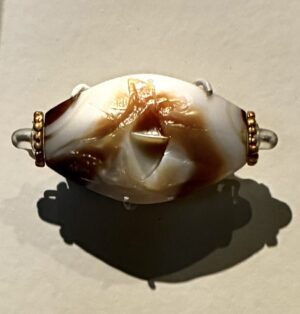
The agate as seen unaided at the special exhibit, The Kingdom of Pylos: Warrior-Princes of Ancient Greece, the Getty Villa Museum.
_____________________________
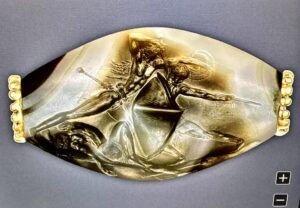
Enhanced view of the agate as shown at the special exhibit, The Kingdom of Pylos: Warrior-Princes of Ancient Greece, the Getty Villa Museum. “A horizontal lathe to make fine cuts, along with emory, olive oil and ground stone, were used to make the fine cuts,” said Claire Lyons, Curator of Antiquities for the J.Paul Getty Museum. Based on recent research, says Lyons, “it was not about the artist’s eye” that created this remarkable piece of work, “it was about the artist’s feel” of the material.
_____________________________
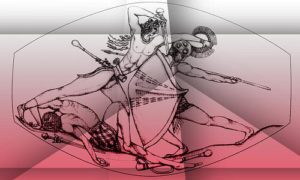
A digitally altered illustration of the seal found in the tomb of the Griffin Warrior. Courtesy Department of Classics, University of Cincinnati, as published in the article, Uncovering the Early Mycenaeans in Popular Archeology Magazine, January 7, 2020.
_____________________________
“Some of the details on this are only a half-millimeter big,” said Davis. “They’re incomprehensibly small.”***
The image on the stone portrayed a warrior in the process of defeating two opponents, one already laying dead at his feet, and in the act of plunging a sword into the neck of the shielded second opponent — a scene of Achaean combat that could be likened to any event from the pages of Homer’s Iliad.
_________________________
A Rare Treasure at the Getty Villa Museum
The amazing discoveries and revelations at Pylos notwithstanding, their appreciation has remained primarily via the pages of journals, magazines, and online articles published by the popular press, and through research papers and reports written for academics. Now, however, for the first time, the tomb treasure of the warrior prince, the Pylos kingdom, and the Mycenaeans have journeyed nearly 7,000 miles to the sunny coast of southern California. From June 27, 2025 to January 12, 2026, the Getty Villa Museum showcases the original artifacts in a well-appointed and captivating gallery space, drawing thousands of visitors and enthusiasts to see, in person, many of the most significant objects that have now made the Pylos discoveries among the most iconic finds of Greek archaeology.
“These are truly unique objects,” says Claire Lyons, who is Curator of Antiquities for the J.Paul Getty Museum, working directly with the Getty Villa Museum, “because, among other things, this is 100 percent archaeologically excavated and documented material.” Along with the incredible ‘combat agate’ and other seal stones exhibited in the special gallery, she points to a reconstructed artifact that, though perhaps less ‘glamorous’ on the stage among these artifacts, deserves equal attention — an early Mycenaean helmet made of boar tusks, a typical part of the military attire of the ancient Mycenaean warrior. “The boar-tusked helmet is totally new,’ she remarks. “It is unpublished material” in the way of display pieces for an exhibit of this kind for this time period.
The exhibit was years in the making. “We’ve had this ongoing relationship with the Ministry of Culture of Greece,” she went on to say. “So when it came time to take the first step in 2021 [to put together the exhibit show in the U.S.] everyone was enthusiastic.”
She emphasized that the show is much more than a display of select artifacts excavated from a certain tomb. “It’s about Messenia, what has been found there.” The ancient region of Messenia was mentioned in the Iliad. Pylos was a prominent center of administration and culture during the Late Bronze Age within Messenia. A number of artifacts exhibited in the gallery space come from other locations and excavations besides Pylos.
_______________________________
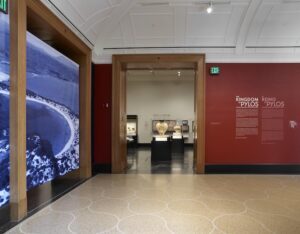
Above and two images below: views of the special exhibit gallery space. Images courtesy J. Paul Getty Trust
_______________________________
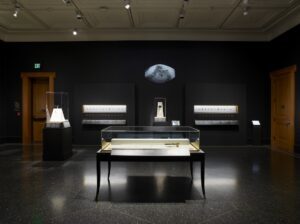
_______________________________
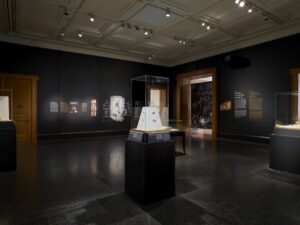
_______________________________
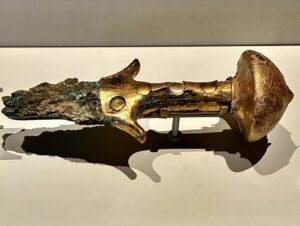
The hilt of the Griffin Warrior’s sword is embellished with “gold embroidery”, a labor-intensive Mycenaean technique of inserting tiny L-shaped gold wires into the ivory pommel and grip. After burnishing the gold to create a smooth surface, the artisan incised it with patterns and figures. Here the engraved scenes of animal combat, with lions attacking wild goats native to Crete, mirror the warior culture of Mycenaean palace society. Text and special exhibit display image courtesy J. Paul Getty Trust
_______________________________
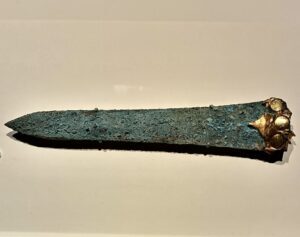
The handle of this elaborate dagger is partly preserved at the attachment to the blade, where it was secured by three bronze rivets covered by large gold caps. Tiny L-shaped gold wires were set into the dagger’s handle, as on the hilt of the Griffin Warrior’s sword. The gold surface was then embellished with a net of engraved spirals on both sides. Text and special exhibit display image courtesy J. Paul Getty Trust
_______________________________
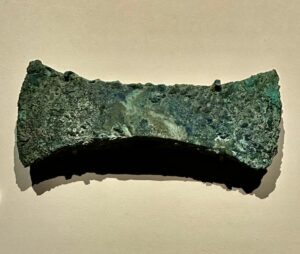
This utilitarian axe may have been developed by the Minoans in part for shaping stone building blocks of the sort used at Pylos as early as the 1500s BCE. Several such blocks were found in the stone foundation of the Griffin Warrior’s grave. Text and special exhibit display image courtesy j. Paul Getty Trust
_______________________________
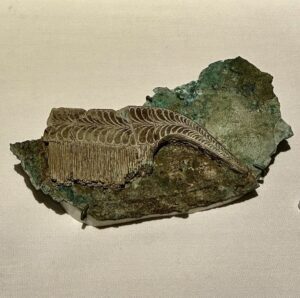
Ivory combs are not uncommon in Late Bronze Age burials, and the Griffin Warrior’s grave held five, probably imported from Crete. This ornate example was stuck to a piece of his bronze armor. Finds of cosmetic implements attest to the widespread emphasis on grooming and beautification in the warrior culture of Greece and other Bronze Age societies. Text and special exhibit display image courtesy of j. Paul Getty Trust
_______________________________
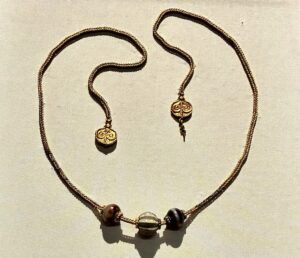
Gold beaded necklace found in the Griffin Warrior’s grave. Elite Mycenaean and Minoam warriors wore jewelry, including armlets and bracelets strung with sealstones. Myriad carnelian, amethyst, amber, and gold beads were found in the Grifin Warror’s burial, deposited by the living to adorn the hero’s body in death. Text and special exhibit display image courtesy J. Paul Getty Trust
_______________________________
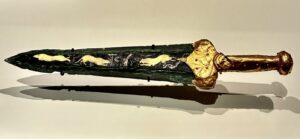
Above and below: inlaid daggers found in the grave of a Mycenaean woman, perhaps a princess of Pylos. Text and special exhibit display image courtesy J. Paul Getty Museum
_______________________________
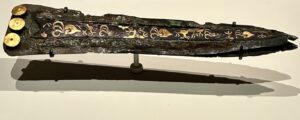
_______________________________
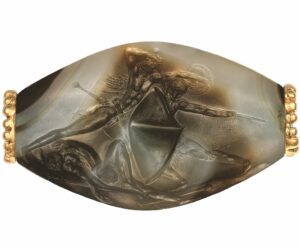
The combat agate, found in the Griffin Warrior grave. © Hellenic Ministry of Culture – HOCRED /
Archaeological Museum, Chora, SN18-0112/ © Palace of Nestor Excavations, Department of Classics, University of Cincinnati / Photo: Jeff Vanderpool
____________________________
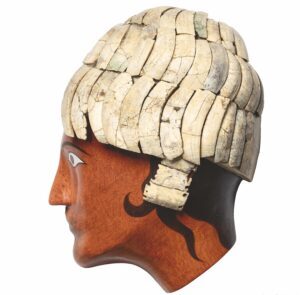
Boar’s-Tusk Helmet, Mycenaean, 1520–1440 BCE Boar’s tusk, set on a modern plaster head © Hellenic Ministry of Culture – HOCRED /Archaeological Museum of Messenia, Kalamata, AMM 11943. Image © J. Paul Getty Trust, photo: Jeff Vanderpool
____________________________
The Getty Villa Museum
Few museums in the world can match the unique splendor of the Getty Villa Museum in Los Angeles. Set near the iconic southern California coastline that boasts such famous surfing beaches as Malibu and Santa Monica, its structure exemplifies the quintessence of a sumptuous ancient Roman villa. The incredible Roman villa remains of Pompeii and Herculaneum in Italy are magnificent to behold in and of themselves, but none can compare in completeness to the reconstruction one sees with the villa in LA, modeled as it were after the famous Villa of the Papyri, the partially excavated remains of which can be seen in a corner of the dramatic multi-story remnants of Herculaneum.
Jean Paul Getty initially opened the museum in 1974, though it was renovated in 2006. Today it houses one of the world’s best collections of antiquities, especially Greek, Roman and Etruscan, and is recognized as a center of scholarship and conservation.
Following is a pictorial sampling of the museum’s not-to-be-missed permanent spaces and treasures….
_____________________________
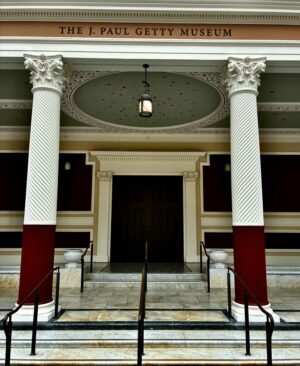
_____________________________
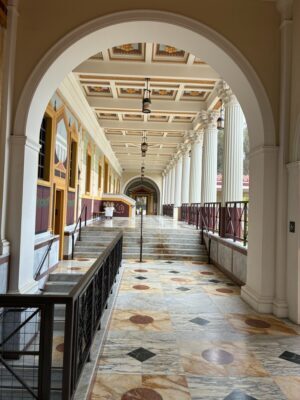
_____________________________
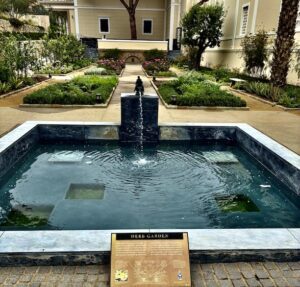
Courtesy J. Paul Getty Trust
_____________________________
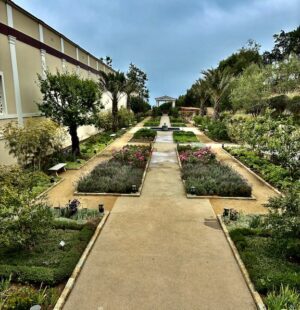
_____________________________
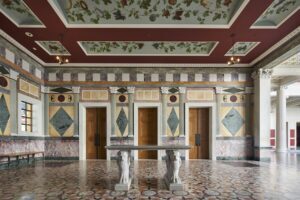
Courtesy J. Paul Getty Trust
_____________________________
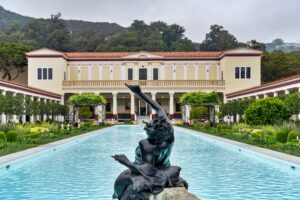
Courtesy J. Paul Getty Trust
_____________________________
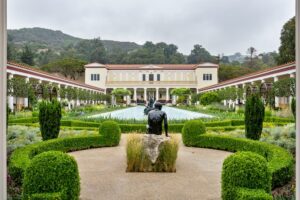
Courtesy J. Paul Getty Trust
_____________________________
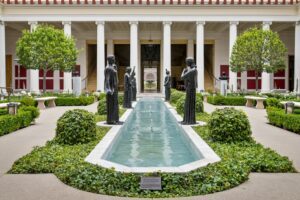
Courtesy J. Paul Getty Trust
_____________________________
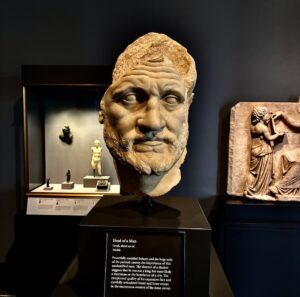
_____________________________
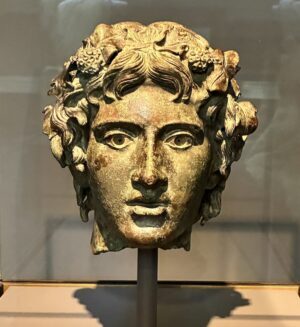
_____________________________
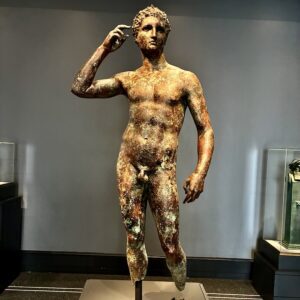
_____________________________
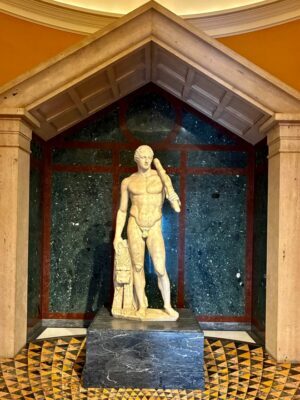
_____________________________
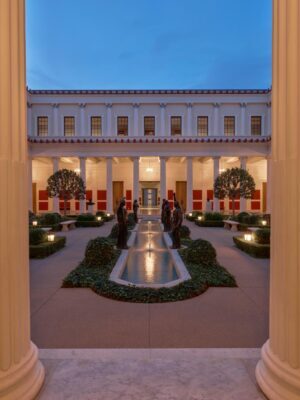
_____________________________
See more about the Getty Villa and start your visit to this remarkable museum here.
_____________________________
*https://popular-archaeology.com/article/archaeologists-find-bronze-age-tombs-lined-with-gold/

